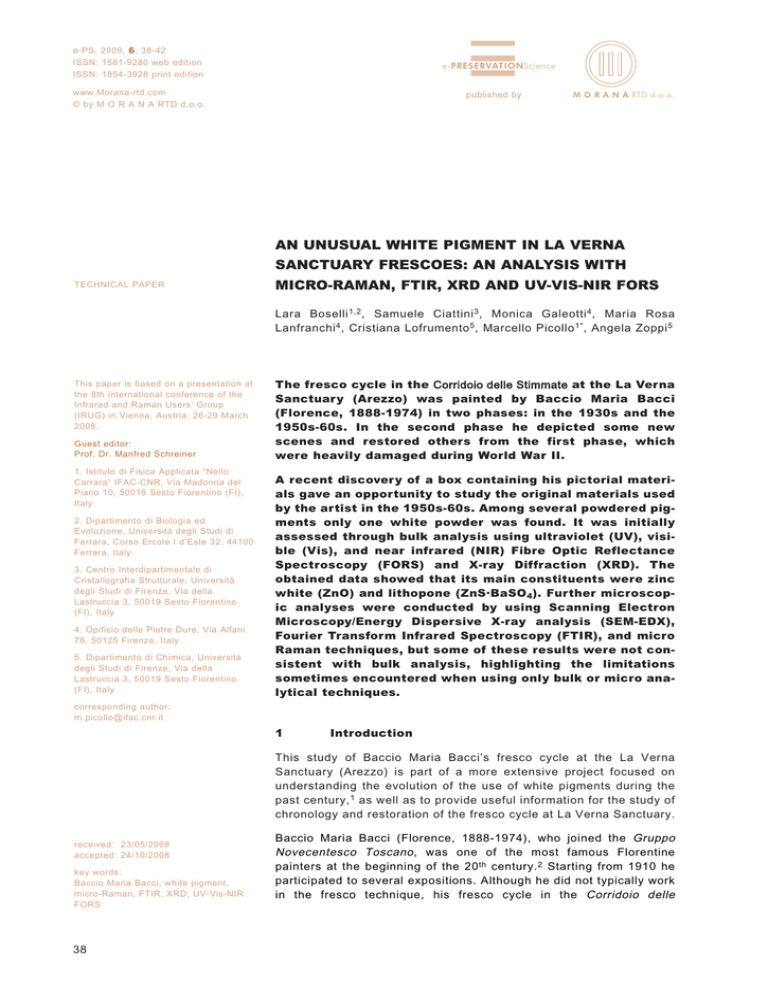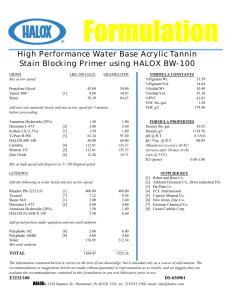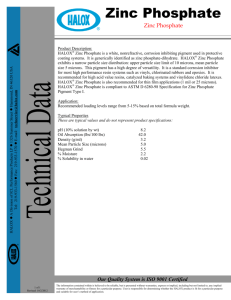e-PS, 2009, , 38-42 ISSN: 1581-9280 web edition e-PRESERVATIONScience
advertisement

e-PS, 2009, 6, 38-42 ISSN: 1581-9280 web edition ISSN: 1854-3928 print edition e-PRESERVATIONScience www.Morana-rtd.com © by M O R A N A RTD d.o.o. published by M O R A N A RTD d.o.o. AN UNUSUAL WHITE PIGMENT IN LA VERNA SANCTUARY FRESCOES: AN ANALYSIS WITH TECHNICAL PAPER MICRO-RAMAN, FTIR, XRD AND UV-VIS-NIR FORS Lara Boselli 1,2 , Samuele Ciattini 3 , Monica Galeotti 4 , Maria Rosa Lanfranchi 4 , Cristiana Lofrumento 5 , Marcello Picollo 1* , Angela Zoppi 5 This paper is based on a presentation at the 8th international conference of the Infrared and Raman Users’ Group (IRUG) in Vienna, Austria, 26-29 March 2008. Guest editor: Prof. Dr. Manfred Schreiner 1. Istituto di Fisica Applicata “Nello Carrara” IFAC-CNR, Via Madonna del Piano 10, 50019 Sesto Fiorentino (FI), Italy 2. Dipartimento di Biologia ed Evoluzione, Università degli Studi di Ferrara, Corso Ercole I d’Este 32, 44100 Ferrara, Italy. 3. Centro Interdipartimentale di Cristallografia Strutturale, Università degli Studi di Firenze, Via della Lastruccia 3, 50019 Sesto Fiorentino (FI), Italy 4. Opificio delle Pietre Dure, Via Alfani 78, 50125 Firenze, Italy 5. Dipartimento di Chimica, Università degli Studi di Firenze, Via della Lastruccia 3, 50019 Sesto Fiorentino (FI), Italy The fresco cycle in the Corridoio delle Stimmate at the La Verna Sanctuary (Arezzo) was painted by Baccio Maria Bacci (Florence, 1888-1974) in two phases: in the 1930s and the 1950s-60s. In the second phase he depicted some new scenes and restored others from the first phase, which were heavily damaged during World War II. A recent discovery of a box containing his pictorial materials gave an opportunity to study the original materials used by the artist in the 1950s-60s. Among several powdered pigments only one white powder was found. It was initially assessed through bulk analysis using ultraviolet (UV), visible (Vis), and near infrared (NIR) Fibre Optic Reflectance Spectroscopy (FORS) and X-ray Diffraction (XRD). The obtained data showed that its main constituents were zinc white (ZnO) and lithopone (ZnS·BaSO 4). Further microscopic analyses were conducted by using Scanning Electron Microscopy/Energy Dispersive X-ray analysis (SEM-EDX), Fourier Transform Infrared Spectroscopy (FTIR), and micro Raman techniques, but some of these results were not consistent with bulk analysis, highlighting the limitations sometimes encountered when using only bulk or micro analytical techniques. corresponding author: m.picollo@ifac.cnr.it 1 Introduction This study of Baccio Maria Bacci’s fresco cycle at the La Verna Sanctuary (Arezzo) is part of a more extensive project focused on understanding the evolution of the use of white pigments during the past century, 1 as well as to provide useful information for the study of chronology and restoration of the fresco cycle at La Verna Sanctuary. received: 23/05/2008 accepted: 24/10/2008 key words: Baccio Maria Bacci, white pigment, micro-Raman, FTIR, XRD, UV-Vis-NIR FORS 38 Baccio Maria Bacci (Florence, 1888-1974), who joined the Gruppo Novecentesco Toscano , was one of the most famous Florentine painters at the beginning of the 20 th century. 2 Starting from 1910 he participated to several expositions. Although he did not typically work in the fresco technique, his fresco cycle in the Corridoio delle © by M O R A N A RTD d.o.o. Stimmate at the La Verna Sanctuary (Arezzo), dealing with San Francesco’s life cycle, is considered one of his most important artworks. He worked on these frescoes from 1929 to 1940, when Italy entered the Second World War. In the summer of 1944 the Sanctuary was on the front line between German and Allied troops and was severely damaged. After the war, in 1959, Baccio Maria Bacci was called by the monks to restore his damaged frescoes. During this second intervention, the artist retouched several scenes and in filled losses using a tempera medium. Finally, in 1961-62 he added two new scenes at this fresco cycle. 3 Recently, a box containing his pictorial materials was discovered in the attic of La Verna Sanctuary, giving an opportunity to study the original materials used by the artist in the 1950s-60s. Among several powdered pigments only one white powder was found. It was decided to include its analysis in the more extensive project on white pigments. In this period, several white pigments were available for artists: lead white (2PbCO 3 ·Pb(OH) 2 ), lithopone (ZnS·BaSO 4 ), zinc white (ZnO) and titanium dioxide (TiO 2 ), the latter manufactured in both the rutile and anatase forms. 1 Other white materials, such as kaolin (also called china clay or hydrated aluminium silicate), calcite (calcium carbonate), gypsum (calcium sulphate dehydrate), and barium sulphate have also been used for artistic purposes, but mainly as fillers, which are commonly used in pigmented grounds and primers. 1 Initially, Baccio Maria Bacci’s white powder was analysed using FORS and powder XRD. Both techniques were performed as bulk analysis, and required a larger amount of material (up to a few grams of powder), in order to macroscopically characterise the pigment. Subsequently, other analytical techniques were used to study this pigment on a microscopic level. For this part of the work SEM-EDX, micro-Raman and FTIR (both macro- and micro-) were used. 2 Experimental 2.1 FORS FORS measurements in the 300-2150 nm range were performed on approximately 10 g of the white powder by using the Zeiss MCS601 (200-1000 nm range) and MCS611 NIR 2.2WR (900-2150 nm range) spectroanalyzers. The data acquisition intervals were of 0.8 nm/pixel and approximately of 5.0 nm/pixel, respectively. Two different sets of measurements were carried out: one in the 3502150 nm range (Figure 1) and the other in the 300- 800 nm range (Figure 2). The radiation, guaranteed by a tungsten-halogen lamp (module Model CLH500) and by xenon light source (module Model CLX500) respectively, is carried to the sample by a bundle of optical fibres. The probe used was a dark hemisphere, 3 cm in diameter, terminating in a flat base, with three apertures on the dome for the passing of the light sent and the light backscattered by the investigated surface. The reflectance spectra were recorded on a small area of about 0.3 cm 2 , using 99% Spectralon ® diffuse reflectance standard. Each measurement was obtained by averaging three acquisitions. The white powder was pressed to produce three flat and hard surface samples suitable to be measured with the above-mentioned probe. On each sample five measurements were acquired. For the measurements in the 350-2150 nm range, the junction point of the two detectors, at around 980 nm, may produce in the acquired spectra a discontinuity in the spectral shape, such as a sharp increase/decrease in reflectance (Figure 1). 2.2 XRD Powder XRD was performed on a few grams of the powder with a Bruker D8-advance X-ray diffractometer with Cu Kα (λ = 1.54178 Å) radiation. The instrument is provided of theta-theta goniometer where both the detector and the X-ray tube source can move (classical Bragg-Brentano geometry). The diffractometer has a reception slit of 0.1 mm. The range for the scan of the white powder was from 3° 2θ to 60° 2θ. A multi-channel energy dispersion detector (SOLXX) allowed for acquisition of scans in approximately 20 min. Two diffractograms were acquired on the white powders. 2.3 SEM The instrument used for the analysis was a SEMEDX Leica Stereoscan 440 with an Oxford Link Gem energy dispersive detector for EDX analysis. The acceleration voltage used was 20 kV and the probe current was 200 pA. The sample (a few mg of powder) was mounted on an aluminium stub with a conductive adhesive and carbon coated. EDX analysis was performed on a large number of particles of the pigment sample. 2.4 Micro-Raman Measurements were performed using a single grating RM2000 Renishaw spectrometer coupled with a diode laser source emitting light at 785 nm, determining a spectral resolution of about 3 cm -1 . An Unusual White Pigment In La Verna Sanctuary Frescoes, e-PS, 2009, 6, 38-42 39 www.e-PRESERVATIONScience.org Some μg of the material was placed under the microscope and then investigated on five different points through a 50× magnification objective, which provides a laser spot of about 2 μm diameter. The spectra were recorded in the range 100-1400 cm -1 , with a laser power on the sample of about 3 mW and an acquisition time from 30 to 100 s. 2.5 FTIR IR spectra were collected in transmission mode (4000-400 cm -1 ) on eight different samples by using a purged Nicolet Protégé 460 FTIR spectrometer on 13-mm diameter KBr pellets with a spectral resolution of 4 cm -1 (64 scans). Micro-IR spectra were also collected on few μg of the powder flattened over a NaCl pellet with a Continuμm Infrared Microscope linked to a Nicolet Nexus FTIR spectrometer, with a spectral resolution of 4 cm -1 (128 scans). This allowed ten spectra to be collected from different points of the sample, each of them providing the same profile with only slight different relative intensities of the bands. 3 Results and Discussion 3.1 FORS The entire set of FORS spectra of this white powder are strongly characterized by two absorption bands due to the presence of zinc white (ZnO) and zinc sulphide (ZnS), as reported in Figures 1 and 2. Both compounds are semiconductors. The typical S-type band shape of their reflectance spectra corresponds to the electromagnetic energy necessary for electrons to overcome the band gap, and this energy is typical for each semiconductor. 4,5 The position of the inflection point in the reflectance spectra can be identified by calculating the first derivative of the spectra. For ZnS and ZnO, the maximum peaks of the derivative curves are positioned at around 342 and 382 nm, respectively. 1 ZnS could be related with the presence of the white pigment lithopone, which is a mixture of white zinc sulphide and barium sulphate. Moreover, the reported reflectance curves show a composite absorption band in the 650–750 nm range, as for a cobalt(II) ion in a pseudotetrahedral sulphur coordination in ZnS. 6 In fact, this is characteristic of lithopone pigments produced after the mid-1920s. 7 40 Figure 1: UV-Vis-NIR reflectance spectrum of the white pigment Figure 2: UV-Vis reflectance spectra of the white pigment (black line), zinc white laboratory standard (red line), and lithopone laboratory standard (green line). 3.2 XRD In Figure 3 the X-ray diffraction peaks corresponding mainly to the patterns of zincite (ZnO), baryte (BaSO 4 ), and sphalerite (ZnS) are reported. 8 3.3 SEM SEM-EDX offers valuable information concerning the elemental composition of the powder and the materials used by the artist. In the white sample zinc, barium and sulphur were detected (Figure 4). This is consistent with XRD results indicating a composition of zinc white (ZnO), zinc sulphide (ZnS) and baryte (BaSO 4 ), the latter two together are indicative of the pigment lithopone. Strontium was also seen, which could be a substitute of the barium in the baryte. 9 An Unusual White Pigment In La Verna Sanctuary Frescoes, e-PS, 2009, 6, 38-42 © by M O R A N A RTD d.o.o. cm -1 and the weak signals in the 1100 cm -1 region can be attributed to BaSO 4 sulphate vibrations. Moreover these features are always accompanied by two weak bands at 222 and 349 cm -1 , which are characteristic of ZnS. 10 Figure 3: X-ray diffractogram of the white pigment with reported the main diffraction peaks of zinc white (ZW), barium sulphate (BS) and zinc sulphide (ZS). In the spectra 1, 2, and 4 (Figure 5) there is the evidence of the presence of anatase (TiO 2 ), discernible mainly by the intense peak at 641 cm -1 , and the medium ones at 400 and 519 cm -1 ; another characteristic peak of anatase is located at 148 cm -1 , but appears only in spectrum 4 as in the other spectra the low frequency region is cut off by the notch filter used for the Rayleigh rejection. In addition, as depicted in Figure 5, the weak feature which can be observed at 437 cm -1 in spectra 1, 2, 4 and 5 can be ascribed to the zinc white (ZnO) compound. 10 It should be noted that ZnO is a poor scatterer, and the weakness of these signals is in part due to this fact and does not necessarily reflect a low concentration. On the other hand anatase is a good scatterer, which is evinced by the high intensity of its Raman peaks, and again is not wholly due to its amount in the sample. 11 According to these results, the white pigment contains mainly lithopone mixed with anatase as well as zinc white compounds. 3.5 Figure 4: SEM-EDX spectrum of the white pigment. Figure 5: Micro-Raman spectra recorded on five different points selected on the white pigment; the main peaks of zinc white (ZW), barium sulphate (BS), zinc sulphide (ZS) and anatase (A) are reported. 3.4 Micro-Raman All the acquired spectra reported in Figure 5 present an intense signal at 988 cm -1 , which together with the medium bands at 454, 461, 619 and 649 FTIR In the mid-IR spectrum (Figures 6 and 7), barium sulphate shows a distinctive and sharp set of absorption bands at 1075, 1125 and 1185 cm -1 together with the small sharp band at 985 cm -1 . Other bands linked with this compound are found at 635 and 611 cm -1 . 12,13 Working in the 4000-400 cm -1 range it is not possible to distinguish barium sulphate from lithopone, because ZnS presents a typical absorption band in the far IR (around 310 cm -1 ). Zinc white and anatase were not found with FTIR spectroscopy, which may be in part due to the complexity of the FTIR spectra. The bands in the lower IR region may be masking those due to ZnO. Most of the absorption bands found in the spectrum might be due to a melamine formaldehyde resin, although further analysis is necessary to confirm this identification. Melamine formaldehyde resins are thermosetting polymers made by combining formaldehyde with melamine, which have been used by the coating industry particularly for baking finishes. In Figure 7 one of the IR spectra of this white pigment is compared with the reference spectrum of the product Maprenal mf 800 ® , an isobutylated commercial resin. Among the main absorption bands in the spectrum of the white pigment, the strong peak at 1566 cm -1 is related to the aromatic C=N stretching vibration; An Unusual White Pigment In La Verna Sanctuary Frescoes, e-PS, 2009, 6, 38-42 41 www.e-PRESERVATIONScience.org the absorption band at 1375 cm -1 is attributed to the aromatic C-N bending vibration, while the band at 740 cm -1 is due to the CH 2 rocking vibration. Additional spectra were recorded by micro-FTIR in transmission mode in an attempt to separate this unknown substance from the pigment. Several extraction procedures were tested using different solvents (water, methyl alcohol, petroleum ether, cyclohexane and benzene). However, this substance appeared to be strongly bound to the pigment aggregates and was not successfully separated. range of the experimental configuration. Barium sulphate was found with each method except FORS, because it does not have a characteristic absorption in the UV-Vis-NIR range. Surprisingly, anatase was only identified in micro-Raman, probably because it is in low concentration and is easily detected by this technique. This stresses the importance of using a combination of analytical techniques with different sensitivities to different materials. However, even within this approach not all the constituents of the powder were conclusively identified and other analytical techniques more suited to organic analysis are needed. 5 Acknowledgements The authors would like to thank Christina Bisulca, Oscar Chiantore, Rebecca Ploeger, Tommaso Poli and John Twilley for their useful discussions. 6 References 1. M. Bacci, D. Magrini, M. Picollo, B. Radicati, G. Trumpy, M. Tsukada, D. Kunzelman, Modern white pigments: their identification by means of non-invasive ultraviolet, visible and infrared fiber optic reflectance spectroscopy, Proceedings of the Symposium Modern Paints Uncovered, London 16-19/05/2006, Getty Conservation Institute, Los Angeles 2007, 118-128. Figure 6: FTIR spectra of the white pigment. 2. M. Borghi, Baccio Maria Bacci, pittore e scrittore. Collana d’arte Contemporanea. Roma, 1958. 3. B.M. Bacci, I cartoni del ciclo Francescano della Verna , in: S. De Rosa, Ed., Exhibition Catalogue, LoGisma, Firenze, 1996. 4. G. R. Hunt, J. W. Salisbury, and C. J. Lenhoff. Visible and nearinfrared spectra of minerals and rocks IV: Sulphides and sulfates, Mod. Geol., 1971, 3, 1–14. 5. H. Kühn, Zinc white, in: R.L. Feller, Ed., Artist’s pigments - a hanbook of their history and characteristics, vol. 1, Oxford University Press, New York, 1986, 169-186. 6. H. A. Weakliem, Optical spectra of Ni2+, Co2+, and Cu2+ in tetrahedral sites in crystals, J. Chem. Phys., 1962, 36, 2117–2140. 7. M. van Alphen, Paint film components, Australia: National Environmental Health Forum Monographs, General Series No. 2, 1998. Available online at http://enhealth.nphp.gov.au/council/pubs/ pdf/paint.pdf (accessed: 26/03/2009). Figure 7: FTIR spectra of the white pigment (black line) with reported the main absorption bands of barium sulphate (BS), Maprenal mf 800 ® (magenta line), zinc white laboratory standard (orange line) and anatase laboratory standard (violet line). 4 Conclusion The white pigment was found to be a complex mixture of zinc white, lithopone, a minor component of anatase as well as an unidentified organic material. Zinc white and zinc sulphide were found with each technique with the exception of FTIR. Although zinc white should have been detected with FTIR, it was probably masked by the unidentified component, while zinc sulphide is out of the 42 8. A. Lang, Mineral powder diffraction file – data book. JCPDS International Diffraction Data, Swarthmore, USA, 1981. 9. A. Kriete, H. Gundlach, S. Amelinckx, L. Reimer, Microscopy, in: H. Günzler, A. Williams, Eds., Handbook of analytical techniques , Vol. 2, Wiley-VCH, Weinheim, 2001, 1115-1124. 10. I.M. Bell, R.J.K. Clark, P.J. Gibbs, Raman Spectroscopic Library of Natural and Synthetic Pigments (pre- ∼1850 AD). Spectrochim. Acta A, 1997, 53A, 2159-2179. 11. T.C. Damen, S.P.S. Porto, B. Tell, Raman effect in zinc oxide, Phys. Rev., 1966, 142, 570-574. 12. R.L. Feller, Barium sulfate - natural and synthetic, in: R.L. Feller, Ed., Artist’s pigments - a handbook of their history and characteristics, vol. 1, Oxford University Press, New York, 1986, 47-64. 13. www.irug.org (last accessed: 25/05/2008). An Unusual White Pigment In La Verna Sanctuary Frescoes, e-PS, 2009, 6, 38-42






